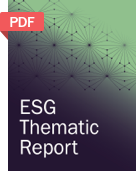Environmental, Social, and Governance (ESG) in the 3D Printing Construction Industry
ESG Investing, Environmental, Social and Governance - is a type of focused investment and an asset class that is growing in popularity. ESG Reporting shows whether a company has made public statements about its ESG performance, as well as the inclusion of such information in regulatory filings.
27% of the world's CO2 emissions are caused by the construction sector, and thus progress towards sustainability is slow. Alternative methods such as 3D printing can help in reducing the emissions. 3D printing is a process where 3D objects are created from a digital file. The 3D printing industry also known as additive manufacturing industry is already sustainable right now. As per the study, 3D printing reduces 65% of the conventional construction cost of material.
The application of 3D printing in the building sector is groundbreaking and attracting significant interest worldwide. The construction industry's increasing use of 3D printers for accurate end-product prototyping, design, and creation and cutting production costs is accelerating the market's growth. Building construction companies are rapidly adopting 3D printing and green construction techniques to build structures that are energy efficient and to change the structure of supply chains.
Environmental Impacts Within the ESG Space from The 3D Printing Construction Sector
The industry embodies many environmentally positive elements. A typical 3D printer uses materials such as plastics, concrete, sand, resins, or metals. This method produces a tiny fraction of the waste as compared to conventional construction manufacturing as builders simply print exactly and only what they need.
Thus, reduction of waste and improved carbon footprint are interesting possibilities. 3D printed houses can be constructed from waste material made of recycled rubble, fiberglass, steel, cement, concrete, and binder.
The cost advantages of 3D printing are measured in terms of their capacity to reduce construction time, waste, total embodied energy, and traditional requirements such as conventional construction equipment and framework. High precision, increased productivity, lower labour costs, and faster turnaround times are all benefits of 3D printing technology application. Thus, this market can be presented to be affordable to all thereby promoting inclusion among communities, which is a major part of the social aspect within ESG.
Construction of a structure takes almost a year, whereas 3D printing only needs a few days. The benefits of 3D printed concrete include a highly durable architectural design, flexibility, and adaptability to any shape and no need of moulds. Using 3D representations, customers can easily make changes to the design before construction. In accordance with the United Nations’ Sustainable Development Goals, this contributes to the building and development of sustainable cities and communities - SDG 11.
The danger to human health or labour accidents is reduced due to the automation in line to achieve SDG 3 – Good health and well-being. Limitations in 3D printing construction industry is 3D printers consume more energy and are also expensive. Also, there are printer and material emission issues that the industry is steadily addressing.
Growth of 3D Printing Construction Market:
The global 3D printing construction market size was valued at USD 11,268.9 thousand in 2021 and is projected to register a compound annual growth rate (CAGR) of 100.7% from 2022 to 2030. The demand for 3D printing is increasing worldwide and the construction industry is about to undergo a revolution because to this technology.
Key Companies in this theme
• COBOD International A/S
• Yingchuang Building Technique (Shanghai) Co.Ltd.(Winsun)
• XtreeE, Sika AG
• WASP S.r.I
• CyBe Construction
Scope of the 3D Printing Industry ESG Thematic Report:
• Macro-economic and ESG-variable analysis of the industry, including regulatory, policy, and innovation landscape
• Key insights on infrastructure developments and ESG issues affecting the theme
• Identify key initiatives and challenges within the industry
• Identify ESG leaders within the industry
• Understand key initiatives and the impact of companies within the sector to fuel an informed decision-making process
• Analysis of industry activities based on multi-media sources, including significant controversies and market sentiment.
Key Benefits of the 3D Printing Industry ESG Thematic Report:
• Developing a comprehensive understanding of macro-economic, Policies & Regulations and innovations affecting the 3D printing construction sector, globally
• Key insights into Infrastructure developments and ESG issues affecting the theme
• Identifying ESG risks and opportunities to business among leading players in the sector
• Obtaining a clear and relevant understanding of company actions, progress, and impact and find opportunities for investment.


